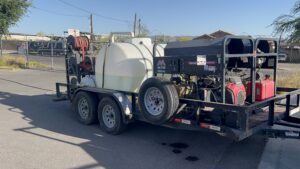Table of Contents
- Introduction to Pressure Washing
- Selecting the Right Pressure Washer
- Pressure Washing Techniques for Different Surfaces
- Safety Measures and Precautions
- Pressure Washer Maintenance and Troubleshooting
- Environmental Considerations
- Conclusion
Introduction to Pressure Washing
Welcome to our comprehensive guide to pressure washing. Pressure washing is an efficient and effective method of cleaning various surfaces, including sidewalks, driveways, decks, siding, and roofs. By using high-pressure water spray, it can quickly remove dirt, mold, grime, and other contaminants. This guide will help you understand the fundamentals of pressure washing, select the right equipment, use proper techniques, and ensure safety throughout the process.
Selecting the Right Pressure Washer
Before you start pressure washing, it’s essential to choose the right equipment. Pressure washers come in different types, power ratings, and capabilities. Here’s a breakdown of the main factors to consider:
Gas vs. Electric Pressure Washers
Gas pressure washers are more powerful and portable, making them suitable for heavy-duty cleaning tasks. They often require more maintenance but provide more flexibility for outdoor use.
Electric pressure washers are quieter, lighter, and easier to maintain. They are ideal for light to medium-duty cleaning tasks and are best for residential use.
Power Ratings: PSI and GPM
The power of a pressure washer is measured in two primary units: pounds per square inch (PSI) and gallons per minute (GPM). PSI measures the pressure generated by the washer, while GPM measures the water flow rate.
- Light-duty: 1300-2000 PSI, 1-2 GPM (ideal for small patios, furniture, and cars)
- Medium-duty: 2000-2800 PSI, 2-3 GPM (suitable for decks, fences, and driveways)
- Heavy-duty: 2900-3300 PSI, 3-4 GPM (best for large driveways, paint stripping, and graffiti removal)
- Professional-grade: 3300+ PSI, 4+ GPM (intended for commercial use and stubborn stains)
Pressure Washing Techniques for Different Surfaces
Each surface requires specific techniques and considerations to ensure safe and effective cleaning. Here are some tips for common surfaces:
Wood Decks and Fences
- Use a low-pressure nozzle (40-degree) to prevent damage.
- Work in the direction of the wood grain.
- Apply a wood cleaner or brightener before pressure washing.
Concrete and Brick Surfaces
- Use a medium-pressure nozzle (25-degree) for efficient cleaning.
- Apply a detergent or degreaser to break down stains.
- Use a surface cleaner attachment for large areas.
Vinyl Siding
- Use a low-pressure nozzle (40-degree) to avoid water infiltration.
- Work from top to bottom and maintain a consistent distance.
- Apply a mild detergent to clean mold and mildew.
Cars and Vehicles
- Use a low-pressure nozzle (40-degree) to prevent paint damage.
- Apply a car wash detergent and use a brush attachment for scrubbing.
- Rinse thoroughly and avoid high-pressure nozzles on tires.
Safety Measures and Precautions
Pressure washing can be dangerous if not handled properly. Follow these safety measures to prevent accidents:
- Wear protective gear, including goggles, gloves, and closed-toe shoes.
- Never point the pressure washer at people, animals, or fragile surfaces.
- Use the appropriate nozzle for each surface and task.
- Engage the safety lock on the trigger when not in use.
- Keep the pressure washer and electrical cords away from water sources.
- Be aware of your surroundings, especially when working on elevated surfaces.
- Follow the manufacturer’s guidelines for safe operation and maintenance.
Pressure Washer Maintenance and Troubleshooting
Proper maintenance is crucial for the longevity and performance of your pressure washer. Follow these steps to ensure it remains in top condition:
- Check and change the oil regularly as per the manufacturer’s recommendations.
- Clean or replace the air filter to ensure optimal airflow.
- Inspect and replace damaged hoses, nozzles, and connectors.
- Clean the water inlet filter to prevent debris from entering the pump.
- Store the pressure washer in a dry and protected area to avoid damage from weather and moisture.
If you encounter issues with your pressure washer, consult the user manual for troubleshooting tips, or contact the manufacturer for assistance.
Environmental Considerations
Pressure washing can have an impact on the environment. Follow these guidelines to minimize the effects:
- Use biodegradable and eco-friendly cleaning solutions.
- Avoid using excessive water by using appropriate nozzles and techniques.
- Be mindful of water runoff, as it may contain pollutants that could harm plants, animals, or local water sources.
- Dispose of wastewater according to local regulations and guidelines.
Conclusion
Pressure washing is an effective and versatile method of cleaning various surfaces, but it requires knowledge, skill, and proper equipment. By following the tips and techniques outlined in this guide, you can ensure a safe, efficient, and environmentally-friendly cleaning experience. With proper maintenance and care, your pressure washer will serve you well for years to come.







Comments are closed